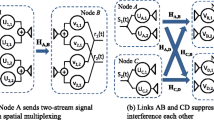Abstract
Use of multiple channels can significantly improve the throughput of wireless mesh networks (WMNs). Additionally, recent advances in radio technology have made it possible to realize software-defined radio (SDR), which is capable of switching from one channel to another dynamically. On the other hand, equipping wireless nodes with multiple antennas creates great potential for throughput improvement via interference suppression, spatial multiplexing, and spatial division multiple access techniques. In this paper, we investigate the joint optimization of routing and scheduling in multichannel WMNs, where nodes are equipped with a single SDR and multiple antenna elements. We analyze achievable throughput of these networks under four different multiantenna modes: single user single stream, single user multi stream, multi user single stream, and multi user multi stream, each mode integrates different combinations of multiantenna techniques. We mathematically model scheduling and interference constraints and formulate joint routing and scheduling optimization problem with the objective of maximizing the throughput by minimizing network schedule time such that traffic demands for a set of sessions are satisfied. A column generation-based decomposition approach is proposed to solve the problem. Simulation results are presented to evaluate the impact of number of antennas, number of channels, and number of sessions on the schedule time for the four proposed modes.
Similar content being viewed by others
References
Akyildiz I., Wang X., Wang W. (2005) Wireless mesh networks: A survey. Computer Networks 47(4): 445–487
Bansal, M., & Trivedi, A. (2011). Joint routing and stream control scheduling in mimo-based wmns. In Proceedings of 20th international conference on computer communications and networks (ICCCN) (pp. 1–6). New York: IEEE.
Bansal, M., & Trivedi, A. (2011). Joint stream allocation and scheduling for single-user mimo communication in wmns. In Proceedings of IEEE national conference on communications (NCC) (pp. 1–5).
Bhatia, R., & Li, L. (2007). Throughput optimization of wireless mesh networks with MIMO links. In Proceddings of IEEE INFOCOM (pp. 2326–2330).
Bruno R., Conti M., Gregori E. et al (2005) Mesh networks: Commodity multihop ad hoc networks. IEEE Communications Magazine 43(3): 123–131
Cao M., Wang X., Kim S., Madihian M. (2007) Multi-hop wireless backhaul networks: A cross-layer design paradigm. IEEE Journal on Selected Areas in Communications 25(4): 738–748
Chen R., Heath R., Andrews J. (2007) Transmit selection diversity for unitary precoded multiuser spatial multiplexing systems with linear receivers. IEEE Transactions on Signal Processing 55(3): 1159–1171
Chvátal V. (1983) Linear programming. WH Freeman, San Francisco, CA
Gilmore P., Gomory R. (1961) A linear programming approach to the cutting-stock problem. Operations Research 9(6): 849–859
Gilmore P., Gomory R. (1963) A linear programming approach to the cutting stock problem-Part II. Operations Research 11(6): 863–888
Gupta P., Kumar P. (2000) The capacity of wireless networks. IEEE Transactions on Information Theory 46(2): 388–404
Hamdaoui, B., & Shin, K. (2007). Characterization and analysis of multi-hop wireless MIMO network throughput. In Proceedings of the 8th ACM international symposium on mobile ad hoc networking and computing (pp. 120–129).
Hamdaoui B., Shin K. (2010) Maximum achievable throughput in multiband multiantenna wireless mesh networks. IEEE Transactions on Mobile Computing 9(6): 838–849
Jafar S., Goldsmith A. (2005) Isotropic fading vector broadcast channels: The scalar upper bound and loss in degrees of freedom. IEEE Transactions on Information Theory 51(3): 848–857
Jaiswal S., Ganz A., Mettu R. (2009) An optimization framework for demand-based fair stream allocation in MIMO ad hoc networks. Mobile Networks and Applications 14(4): 451–469
Johansson M., Xiao L. (2006) Cross-layer optimization of wireless networks using nonlinear column generation. IEEE Transactions on Wireless Communications 5(2): 435–445
Liu, J., Shi, Y., & Hou, Y. (2010). A tractable and accurate cross-layer model for multi-hop mimo networks. In Proceedings of IEEE INFOCOM (pp. 1–9). New York: IEEE.
Luo, L., Raychaudhuri, D., & Liu, H. (2009). Channel assignment, stream control, scheduling and routing in multi-radio mimo wireless mesh networks. In IEEE ICC workshops (pp. 1–5).
Mumey, B., Tang, J., & Hahn, T. (2008). Joint stream control and scheduling in multihop wireless networks with MIMO links. In Proceedings of IEEE ICC (pp. 2921–2925).
Mumey, B., Tang, J., & Hahn, T. (2010). Algorithmic aspects of communications in multihop wireless networks with mimo links. In: IEEE international conference on communications (ICC) (pp. 1–6).
Onggosanusi E., Sayeed A., Van Veen B. (2003) Efficient signaling schemes for wideband space-time wireless channels using channel state information. IEEE Transactions on Vehicular Technology 52(1): 1–13
Schubert, M., Shi, S., & Boche, H. (2006). Iterative transceiver optimization for linear multiuser mimo channels with per-user mmse requirements. In Proceedings of European signal processing conference (EUSIPCO 2006) Italy: Firenze.
Spencer Q., Swindlehurst A., Haardt M. (2004) Zero-forcing methods for downlink spatial multiplexing in multiuser mimo channels. IEEE Transactions on Signal Processing 52(2): 461–471
Srinivasan, R., Blough, D., Cortés-Pena, L., & Santi, P. (2010). Maximizing throughput in mimo networks with variable rate streams. In European wireless conference (pp. 551–559). New York: IEEE.
Tassiulas L., Ephremides A. (1992) Jointly optimal routing and scheduling in packet radio networks. IEEE Transactions on Information Theory 38(1): 165–168
Wang J., Du P., Jia W., Huang L., Li H. (2008) Joint bandwidth allocation, element assignment and scheduling for wireless mesh networks with MIMO links. Computer Communications 31(7): 1372–1384
Wolniansky, P., Foschini, G., Golden, G., & Valenzuela, R. (1998). V-blast: An architecture for realizing very high data rates over the rich-scattering wireless channel. In International symposium on signals, systems, and electronics (pp. 295–300). New York: IEEE.
Yazdanpanah, M., Assi, C., & Shayan, Y. (2010). Cross-layer optimization of wireless mesh networks with multi-antenna beam-forming. In Proceedings of IEEE WCNC (pp. 1–6).
Yazdanpanah, M., Assi, C., & Shayan, Y. (2011). Cross-layer optimization for wireless mesh networks with smart antennas. In Computer communications (pp. 1894–1911).
Author information
Authors and Affiliations
Corresponding author
Rights and permissions
About this article
Cite this article
Bansal, M., Trivedi, A. Cross-Layer Optimization of Multichannel Multiantenna WMNs. Wireless Pers Commun 71, 1443–1459 (2013). https://doi.org/10.1007/s11277-012-0884-z
Published:
Issue Date:
DOI: https://doi.org/10.1007/s11277-012-0884-z




